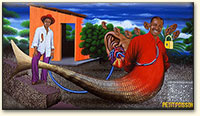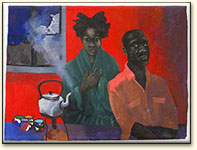Contemporary African Painting
Contemporary African painting is as diverse and complex as African art of the past. Its “African” identity is discernible in iconography rather than materials, techniques, or styles. Two artists whose two-dimensional work is characterized by vivid color are Chéri Samba (b.1956, Congo) and Zwelethu Mthethwa (b. 1969, South Africa). Both artists express responses to post-colonialism.

Le Secret d’un Petit Poisson Devenu Grand, Chéri Samba, 2002. Samba uses color contrasts to convey a positive message.
Samba, a self-taught artist from the Congo, has lived most of his life in an independent African state rife with civil war and corruption. His paintings, which often include text, comment on Congolese urban modernity, cultural contacts with the West, and the impact of consumerism on African society. After exhibiting small paintings locally, Samba was discovered by an international audience; he now works in Paris and Kinshasa on large canvases in acrylic. Le Secret d’un Petit Poisson Devenu Grand (2002) uses color contrasts (complementary orange-blue and red-green) to convey a positive message in his narrative of the small fish that has become large by listening to and trusting the voice of his own heart. Samba’s painting implies that he has defied his modest origins and gained success in bigger seas.

Where Angels Fear to Tread IV, Zwelethu Mthethwa, 2001. Mthethwa uses primary and secondary colors to create tension.
In Where Angels Fear to Tread IV, Zwelethu Mthethwa’s palette, also comprised of primaries and secondaries, creates tension. Living with apartheid and then with its social legacies, Zwelethu, an art school graduate and lecturer, uses color to sustain ideas about alienation and displacement. Mthethwa favors chalk pastel laid down in large, contrasting flat shapes. The red background in Where Angels Fear to Tread presses against the man and woman, becoming an existential force in the interior setting. The homely details of the boiling kettle and the mugs with Zulu designs contrast with the angels outside in the sky. The visceral quality of Mthethwa’s color belies his deeply unsettling analysis of South African township life.